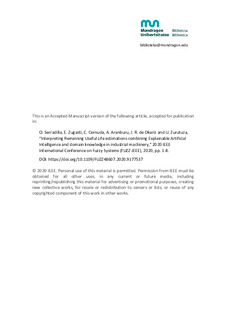Izenburua
Interpreting Remaining Useful Life estimations combining Explainable Artificial Intelligence and domain knowledge in industrial machineryBeste instituzio
Fagor Arrasate, S.Coop.Koniker S.Coop.
Bertsioa
Postprinta
Eskubideak
© 2020 IEEE. Personal use of this material is permitted. Permission from IEEE must be obtained for all other uses, in any current or future media, including reprinting/republishing this material for advertising or promotional purposes, creating new collective works, for resale or redistribution to servers or lists, or reuse of any copyrighted component of this work in other works.Sarbidea
Sarbide irekiaArgitaratzailearen bertsioa
https://doi.org/10.1109/FUZZ48607.2020.9177537Non argitaratua
2020 IEEE International Conference on Fuzzy Systems (FUZZ-IEEE) Argitaratzailea
IEEEGako-hitzak
Explainable Artificial Intelligence
interpret
Machine learning
data-driven model ... [+]
interpret
Machine learning
data-driven model ... [+]
Explainable Artificial Intelligence
interpret
Machine learning
data-driven model
Remaining Useful Life
prognosis
industrial process
domain knowledge [-]
interpret
Machine learning
data-driven model
Remaining Useful Life
prognosis
industrial process
domain knowledge [-]
Laburpena
This paper presents the implementation and explanations of a remaining life estimator model based on machine learning, applied to industrial data. Concretely, the model has been applied to a bushings ... [+]
This paper presents the implementation and explanations of a remaining life estimator model based on machine learning, applied to industrial data. Concretely, the model has been applied to a bushings testbed, where fatigue life tests are performed to find more suitable bushing characteristics. Different regressors have been compared Environmental and Operational Condition and setting variables as input data to prognosticate the remaining life on each observation during fatigue tests, where final model is a Random Forest was chosen given its accuracy and explainability potential. The model creation, optimisation and interpretation has been guided combining eXplainable Artificial Intelligence with domain knowledge.
Precisely, ELI5 and LIME explainable techniques have been used to perform local and global explanations. These were used to understand the relevance of predictor variables in individual and overall remaining life estimations. The achieved results have been process knowledge gain and expert knowledge validation, assertion of huge potential of data-driven models in industrial processes and highlight the need of collaboration between expert knowledge technicians and eXplainable Artificial Intelligence techniques to understand advanced machine learning models. [-]






















